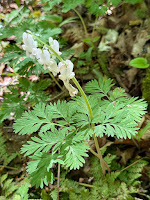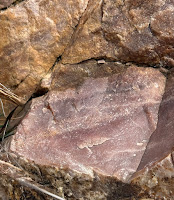If you want to go to nature school, a great place to start is the
Natural Resources Foundation of Wisconsin. This non-profit organization has been in existence for almost 40 years. They not only advocate for WI land, waters and wildlife but annually offer over 250 hands-on guided field trips around the state to get boots on the ground (or paddles in the water) to connect people with learning in and about nature.
 |
Magnolia warbler - bird banding
NRF field trip, May 2023 |
You can pretty much find an interesting trip on any topic: geology, birding, climate resilience, archaeology, insects, outdoor skills, foraging, mammals, amphibians and reptiles, mindfulness, mussels, migration, waterfowl. Many involve hikes, paddling or just observation. The field trips range in difficulty from very easy to extreme.
The trips are low cost and offered around the state. To access the trips, one must be a member of NRF ($35 annually). Membership is open to anyone whether they are WI residents or out-of-state. Members can sign up for 4 trips in early April. After the first week of registrations, additional trips that aren't full yet can be added.
Pro-tip: many trips fill up within seconds after registration opens so membership is a distinct advantage.
Trips costs vary depending on length; whether they are also fundraisers for a partnering organization; additional equipment is provided or other factors. Most trips I've been on start at the low cost of $18 to about $30. Others are higher. The funds go towards supporting conservation in the state. The NRF also provides some limited financial assistance to make it affordable to all.
My two most recent nature school classrooms with the NRF are below:
Classroom1:
Bass Hollow State Natural Area, Mauston WI
Birds and Blooms of Bass Hollow SNA May 16 8am -noon
Extreme: Very steep terrain. Venture off-trail to explore spring wildflowers and migrating birds passing through this forested 100 foot deep natural gorge. Enjoy an inviting view, brimming with many microhabitats. 3 miles, steep hill.
 |
| Bass Hollow ledges |
This four-hour hike with two seasoned DNR biologists introduced a huge number of birds and plants to hikers. We climbed down a steep (and I am saying
steep) forested hill picking our way through and over fallen trees and limbs until we reached the bottom of the gorge where Seven Mile Creek flowed.
Along the pathless way, we spotted and learned about many spring ephemerals, some rare, and identified birds. Our guides took the time to point out rare plants and discuss them and our hiking companions added to the discussion with their knowledge.
 |
| Ladyslipper |
Once we crossed the creek, we hiked up to amazing 100 foot ledges in a hemlock forest. We saw patches of yellow lady-slippers, a flower seldom seen in this area as well as rare forbs like the rattlesnake plaintain orchid,and Parlin's pussytoes as we hiked near the ledge rim.
 |
Hiking through valley
below the ledges |
We then descended down into the valley made by the ledges. The valley was lush with rare ferns and spectacular views of the rock formations. Best of all for phenology-mad-but-poor-memory-me, the guides gave us each a list of birds and plants they had identified the previous week. I only had to check them off to remember what we had seen and talked about. The deep knowledge of the guides and slow pace made time for questions to be answered and curiosity satisfied.
 |
| Squirrel corn |
The final walk back was through a faint path that crossed and re-crossed the creek until we once more bushwhacked our back up the steep slope. It was definitely a great morning at nature school.
**************************
Classroom 2:
Geologic History of the Baraboo Hills May 31 9am-4pm
Challenging: rugged steep hills. The Baraboo Hills are among the oldest rock croppings in North America and a geologic marvel of the Midwet. Hike with an expert to learn how geologic forces, from mountain building to glaciers have shaped this unique landscape. Caravan with stops to hike and explore Van Hise Rock, Abelman's Gorge, Parfrey's Glen and Devil's Lake. 5 miles, rugged steep slopes, stream crossing.
 |
| Baraboo Hills Quartzite |
This was a true immersion into the incredible pink, maroon and purple-colored quartzite rock formations that dominate this region of Wisconsin. Extraordinarily resistant to weathering, these formations tower over the softer rocks of the Wisconsin River Valley. An hour-long lecture (with helpful handout) at the beginning of the day introduced us to the history of this rock and the way, over billions of years, it has gone from ocean floor to being folded, lifted, eroded and shaped into the geological formations we see today.
 |
Vertical rock once
on the ancient ocean floor |
At each stop along the way, our guide showed us examples of the massive forces that shaped the rock and the places where horizontal layers of rock had been pushed up into vertical walls. We could see the sand ripples of an ancient ocean bottom that made up part of the walls next to an old quarry.
 |
Learning about the
Great Unconformity |
While we saw plenty of ephemerals along the hikes during the day, it was the rocks and their formation that we went to school on throughout the day. It was exciting to see the concept of a syncline with our own eyes. Seeing evidence of the Great Unconformity in the rock layers was truly eye-opening. Our guide, Philip Fauble, was patient and had a great way of teaching us without being didactic.
**************************
When you finish guided hikes like these two and want to turn around and do it all over again, I’d say that’s an A+ experience.
 |
Bushwhacking through Parfrey’s Glen
on the geology hike
Image - a sister hiker |
Nature School is what I like to call the guided hikes I go on when I’ve a mind to learn more about the natural world and to fulfill my required training hours to maintain my annual Master Naturalist volunteer certification. The Nature School series highlights parks, organizations and groups that provide free or low-cost guided learning experiences while hiking. The Driftless area of MN, WI and IA is rich in dedicated biologists, naturalists and citizen scientists who share their knowledge, passion and expertise. By doing so, they help hikers of all ages better understand our natural world. It’s always a delight to attend their “schools.”
Check out additional Nature School posts:
Images, unless noted - Marge Loch-Wouters










No comments:
Post a Comment